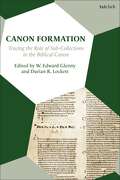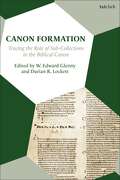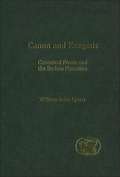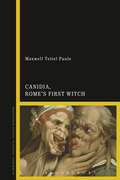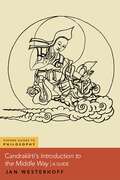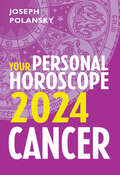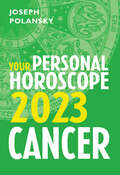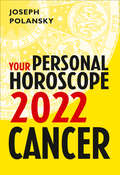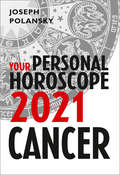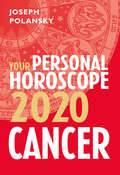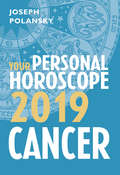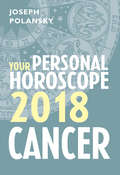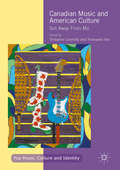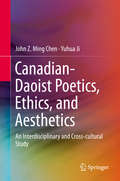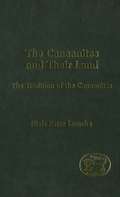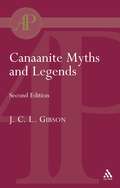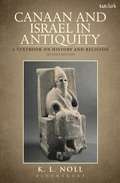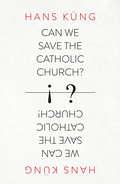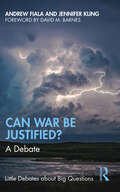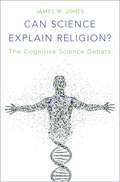- Table View
- List View
Canon Formation: Tracing the Role of Sub-Collections in the Biblical Canon
by W. Edward Glenny and Darian R. LockettContributors to this volume examine the various collections of canonical sub-units in the canon, considering the state of the question regarding each particular collection. The chapters introduce the issues involved in sub-collections being accepted in the canon, summarize the historical evidence of the acceptance of these collections, and discuss the compositional evidence of “canonical consciousness” in the various collections. The contributors consider paratextual evidence, for example, the arrangement of the books in various manuscripts, the titles of the books, and also include evidence such as the presence of catchwords, framing devices, and themes.The book begins with a consideration of the two overarching collections – the Old and New Testaments. Next, several sub-collections within the Hebrew Bible (OT) are considered, including the Torah, Prophets, the Megilloth, the Twelve (both in their Masoretic Text and Septuagint forms), and the Psalter. In addition, sub-collections in the New Testament include the four-fold Gospel, the Pauline Collection (usually with Hebrews in the early manuscripts), the function of Acts within the New Testament, the Praxapostolos (Acts along with the Catholic Epistles), and the function of Revelation as the end of the canon.
Canon Formation: Tracing the Role of Sub-Collections in the Biblical Canon
Contributors to this volume examine the various collections of canonical sub-units in the canon, considering the state of the question regarding each particular collection. The chapters introduce the issues involved in sub-collections being accepted in the canon, summarize the historical evidence of the acceptance of these collections, and discuss the compositional evidence of “canonical consciousness” in the various collections. The contributors consider paratextual evidence, for example, the arrangement of the books in various manuscripts, the titles of the books, and also include evidence such as the presence of catchwords, framing devices, and themes.The book begins with a consideration of the two overarching collections – the Old and New Testaments. Next, several sub-collections within the Hebrew Bible (OT) are considered, including the Torah, Prophets, the Megilloth, the Twelve (both in their Masoretic Text and Septuagint forms), and the Psalter. In addition, sub-collections in the New Testament include the four-fold Gospel, the Pauline Collection (usually with Hebrews in the early manuscripts), the function of Acts within the New Testament, the Praxapostolos (Acts along with the Catholic Epistles), and the function of Revelation as the end of the canon.
Canon and Exegesis: Canonical Praxis and the Sodom Narrative (The Library of Hebrew Bible/Old Testament Studies)
by William John LyonsPrevious attempts to critique the canonical approach of Brevard Childs have remained largely theoretical in nature. One of the weakness of canonical criticism, then, is its failure to have generated new readings of extended biblical passages. Reviewing the hermeneutics and the praxis of Childs' approach, Lyons then turns to the Sodom narrative (Gen 18-19) as a test of a practical exegesis according to Childs' principles, and then to reflect critically upon the reading experience generated. Surprisingly, the canonical reading produced is a wholly new one, centred around the complex, irreducible-even contradictory-request of Abraham for Yahweh to do justice (18:23-25).
Canidia, Rome’s First Witch
by Maxwell Teitel PauleCanidia is one of the most well-attested witches in Latin literature. She appears in no fewer than six of Horace's poems, three of which she has a prominent role in. Throughout Horace's Epodes and Satires she perpetrates acts of grave desecration, kidnapping, murder, magical torture and poisoning. She invades the gardens of Horace's literary patron Maecenas, rips apart a lamb with her teeth, starves a Roman child to death, and threatens to unnaturally prolong Horace's life to keep him in a state of perpetual torment. She can be seen as an anti-muse: Horace repeatedly sets her in opposition to his literary patron, casts her as the personification of his iambic poetry, and gives her the surprising honor of concluding not only his Epodes but also his second book of Satires. This volume is the first comprehensive treatment of Canidia. It offers translations of each of the three poems which feature Canidia as a main character as well as the relevant portions from the other three poems in which Canidia plays a minor role. These translations are accompanied by extensive analysis of Canidia's part in each piece that takes into account not only the poems' literary contexts but their magico-religious details.
Canidia, Rome’s First Witch
by Maxwell Teitel PauleCanidia is one of the most well-attested witches in Latin literature. She appears in no fewer than six of Horace's poems, three of which she has a prominent role in. Throughout Horace's Epodes and Satires she perpetrates acts of grave desecration, kidnapping, murder, magical torture and poisoning. She invades the gardens of Horace's literary patron Maecenas, rips apart a lamb with her teeth, starves a Roman child to death, and threatens to unnaturally prolong Horace's life to keep him in a state of perpetual torment. She can be seen as an anti-muse: Horace repeatedly sets her in opposition to his literary patron, casts her as the personification of his iambic poetry, and gives her the surprising honor of concluding not only his Epodes but also his second book of Satires. This volume is the first comprehensive treatment of Canidia. It offers translations of each of the three poems which feature Canidia as a main character as well as the relevant portions from the other three poems in which Canidia plays a minor role. These translations are accompanied by extensive analysis of Canidia's part in each piece that takes into account not only the poems' literary contexts but their magico-religious details.
Candrak?rti's Introduction to the Middle Way: A Guide (OXFORD GUIDES TO PHILOSOPHY SERIES)
by Jan WesterhoffCandrak?rti's Introduction to the Middle Way (Madhyamak?vat?ra) is a central work of Buddhist philosophy for two reasons. First, it provides an introduction to Madhyamaka, one of the three major philosophical schools of Buddhist thought (the other two being Abhidharma and Yog?c?ra). Second, within Madhyamaka, Candrak?rti's text occupies a very prominent role. This is primarily due to its enormous influence in Tibet, where Candrak?rti's work became the main entry-point into the study of Madhyamaka thought. While the historical importance of the Introduction to the Middle Way for understanding a major section of Buddhist thought is evident, what makes it particularly interesting for students is the role it plays as an 'introduction'. It is one of Candrak?rti's earlier works and presents a comprehensive guide to the key philosophical ideas and problems of Madhyamaka thought. This Oxford Guide is for the philosophically interested student or scholar reading the Introduction to the Middle Way. Westerhoff's commentary focuses on the philosophical content of the text, using Candrak?rti's auto-commentary as the main explicatory resource.
Candrak?rti's Introduction to the Middle Way: A Guide (OXFORD GUIDES TO PHILOSOPHY SERIES)
by Jan WesterhoffCandrak?rti's Introduction to the Middle Way (Madhyamak?vat?ra) is a central work of Buddhist philosophy for two reasons. First, it provides an introduction to Madhyamaka, one of the three major philosophical schools of Buddhist thought (the other two being Abhidharma and Yog?c?ra). Second, within Madhyamaka, Candrak?rti's text occupies a very prominent role. This is primarily due to its enormous influence in Tibet, where Candrak?rti's work became the main entry-point into the study of Madhyamaka thought. While the historical importance of the Introduction to the Middle Way for understanding a major section of Buddhist thought is evident, what makes it particularly interesting for students is the role it plays as an 'introduction'. It is one of Candrak?rti's earlier works and presents a comprehensive guide to the key philosophical ideas and problems of Madhyamaka thought. This Oxford Guide is for the philosophically interested student or scholar reading the Introduction to the Middle Way. Westerhoff's commentary focuses on the philosophical content of the text, using Candrak?rti's auto-commentary as the main explicatory resource.
Cancer 2024: Your Personal Horoscope
by Joseph PolanskyYour complete one-volume guide to the year 2024. This fantastic and in-depth book includes month-by-month forecasts for every sign and all you need to know to find out what is in store for you in the year ahead. The only one-volume horoscope you’ll ever need.
Cancer 2023: Your Personal Horoscope
by Joseph PolanskyYour complete one-volume guide to the year 2023. This fantastic and in-depth book includes month-by-month forecasts for every sign and all you need to know to find out what is in store for you in the year ahead. The only one-volume horoscope you’ll ever need.
Cancer 2022: Your Personal Horoscope
by Joseph PolanskyYour guide to the year 2022. This fantastic book includes month-by-month forecasts and all you need to know to find out what is in store for you in the year ahead. The only horoscope you’ll ever need.
Cancer 2021: Your Personal Horoscope
by Joseph PolanskyYour guide to the year 2021. This fantastic book includes month-by-month forecasts and all you need to know to find out what is in store for you in the year ahead. The only horoscope you’ll ever need.
Cancer 2020: Your Personal Horoscope
by Joseph PolanskyYour guide to the year 2020. This fantastic book includes month-by-month forecasts and all you need to know to find out what is in store for you in the year ahead. The only horoscope you’ll ever need.
Cancer 2019: Your Personal Horoscope
by Joseph PolanskyYour guide to the year 2019. This fantastic book includes month-by-month forecasts and all you need to know to find out what is in store for you in the year ahead. The only horoscope you’ll ever need.
Cancer 2018: Your Personal Horoscope
by Joseph PolanskyYour guide to the year 2018. This fantastic book includes month-by-month forecasts and all you need to know to find out what is in store for you in the year ahead. The only horoscope you’ll ever need.
Canadian Music and American Culture: Get Away From Me
by Tristanne Connolly Tomoyuki IinoThis collection explores Canadian music’s commentaries on American culture. ‘American Woman, get away from me!’ - one of the most resonant musical statements to come out of Canada - is a cry of love and hate for its neighbour. Canada’s close, inescapable entanglement with the superpower to the south provides a unique yet representative case study of the benefits and detriments of the global American culture machine. Literature scholars apply textual and cultural analysis to a selection of Anglo-Canadian music – from Joni Mitchell to Peaches, via such artists as Neil Young, Rush, and the Tragically Hip – to explore the generic borrowings and social criticism, the desires and failures of Canada’s musical relationship with the USA. This innovative volume will appeal to those interested in Music, Canadian Studies, and American Studies.
Canadian Music and American Culture: Get Away From Me
by Tristanne Connolly Tomoyuki IinoThis collection explores Canadian music’s commentaries on American culture. ‘American Woman, get away from me!’ - one of the most resonant musical statements to come out of Canada - is a cry of love and hate for its neighbour. Canada’s close, inescapable entanglement with the superpower to the south provides a unique yet representative case study of the benefits and detriments of the global American culture machine. Literature scholars apply textual and cultural analysis to a selection of Anglo-Canadian music – from Joni Mitchell to Peaches, via such artists as Neil Young, Rush, and the Tragically Hip – to explore the generic borrowings and social criticism, the desires and failures of Canada’s musical relationship with the USA. This innovative volume will appeal to those interested in Music, Canadian Studies, and American Studies.
Canadian-Daoist Poetics, Ethics, and Aesthetics: An Interdisciplinary and Cross-cultural Study
by John Z. Chen Yuhua JiThis monograph takes an interdisciplinary and cross-cultural approach to 20th and 21st -century Canadian Daoist poetry, fiction and criticism in comparative, innovative and engaging ways. Of particular interest are the authors’ refreshing insights into such holistic and topical issues as the globalization of concepts of the Dao, the Yin/Yang, the Heaven-Earth-Humanity triad, the Four Greats, Five Phases, Non-action and so on, as expressed in Canadian literature and criticism – which produces Canadian-constructed Daoist poetics, ethics and aesthetics. Readers will come to understand and appreciate the social and ecological significance of, formal innovations, moral sensitivity, aesthetic principles and ideological complexity in Canadian-Daoist works.
The Canaanites and Their Land: The Tradition of the Canaanites (The Library of Hebrew Bible/Old Testament Studies)
by Niels Peter LemcheIt is an interesting consequence of the new reconstructions of the early history of Israel that the Israelites must originally have been Canaanites. Nevertheless, an outspoken hatred against Canaanites permeates the Old Testament. Lemche presents a new way of explaining the anti-Canaanite sentiments of the Old Testament historians, while at the same time disclosing some of the aims and ideas which governed Old Testament history writing.
Canaanite Myths and Legends
by John C. GibsonTablets of poetic mythological texts unearthed during the excavation of Ugarit have been edited and translated to shed new light on the religion and literature of the ancient world.
Canaan and Israel in Antiquity: Second Edition
by K. L. NollThis comprehensive classic textbook represents the most recent approaches to the biblical world by surveying Palestine's social, political, economic, religious and ecological changes from Palaeolithic to Roman eras. Designed for beginners with little knowledge of the ancient world, and with copious illustrations and charts, it explains how and why academic study of the past is undertaken, as well as the differences between historical and theological scholarship and the differences between ancient and modern genres of history writing. Classroom tested chapters emphasize the authenticity of the Bible as a product of an ancient culture, and the many problems with the biblical narrative as a historical source. Neither "maximalist" nor "minimalist'" it is sufficiently general to avoid confusion and to allow the assignment of supplementary readings such as biblical narratives and ancient Near Eastern texts. This new edition has been fully revised, incorporating new graphics and English translations of Near Eastern inscriptions. New material on the religiously diverse environment of Ancient Israel taking into account the latest archaeological discussions brings this book right up to date.
Canaan and Israel in Antiquity: Second Edition
by K. L. NollThis comprehensive classic textbook represents the most recent approaches to the biblical world by surveying Palestine's social, political, economic, religious and ecological changes from Palaeolithic to Roman eras. Designed for beginners with little knowledge of the ancient world, and with copious illustrations and charts, it explains how and why academic study of the past is undertaken, as well as the differences between historical and theological scholarship and the differences between ancient and modern genres of history writing. Classroom tested chapters emphasize the authenticity of the Bible as a product of an ancient culture, and the many problems with the biblical narrative as a historical source. Neither "maximalist" nor "minimalist'" it is sufficiently general to avoid confusion and to allow the assignment of supplementary readings such as biblical narratives and ancient Near Eastern texts. This new edition has been fully revised, incorporating new graphics and English translations of Near Eastern inscriptions. New material on the religiously diverse environment of Ancient Israel taking into account the latest archaeological discussions brings this book right up to date.
Can We Save the Catholic Church?
by Hans KungThe Catholic Church has been nearly destroyed by its resistance to change, censured for its abuses. Pope Francis has promised reform: radical theologian Hans Küng here presents what Catholics have long been yearning for: modern responses to the challenges of a modern world.
Can War Be Justified?: A Debate (Little Debates about Big Questions)
by Andrew Fiala Jennifer KlingCan war be justified? Pacifists answer that it cannot; they oppose war and advocate for nonviolent alternatives to war. But defenders of just war theory argue that in some circumstances, when the effectiveness of nonviolence is limited, wars can be justified. In this book, two philosophers debate this question, drawing on contemporary scholarship and new developments in thinking about pacifism and just war theory. Andrew Fiala defends the pacifist position, while Jennifer Kling defends just war traditions. Fiala argues that pacifism follows from the awful reality of war and the nonviolent goal of building a more just and peaceful world. Kling argues that war is sometimes justified when it is a last-ditch, necessary effort to defend people and their communities from utter destruction and death. Pulling from global traditions and histories, their debate will captivate anyone who has wondered or worried about the morality of political violence and military force. Topics discussed include ethical questions of self-defense and other-defense, the great analogy between individuals and states, evolving technologies and methods of warfighting, moral injury and post-traumatic stress disorder, broader political and communal issues, and the problem of regional security in a globalizing world. The authors consider cultural and religious issues as well as the fundamental question of moral obligation in a world saturated in military conflict. The book was written in the aftermath of the war on terrorism and includes reflection on lessons learned from the past decades of war, as well as hopes for the future in light of emerging threats in Europe and elsewhere. The book is organized in a user-friendly fashion. Each author presents a self-contained argument, which is followed by a series of responses, replies, and counter-arguments. Throughout, the authors model civil discourse by emphasizing points of agreement and remaining areas of disagreement. The book includes reader-friendly summaries, a glossary of key concepts, and suggestions for further study. All of this will help students and scholars follow the authors’ dialogue so they may develop their own answer to the question of whether war can be justified. Key Features Summarizes the debate between pacifism and just war theory Considers historical and traditional sources as well as contemporary scholarship and applications Models philosophical dialogue and civil discourse, while seeking common ground Discusses issues of concern in contemporary warfighting and peacemaking, while offering an analysis of the war on terrorism
Can War Be Justified?: A Debate (Little Debates about Big Questions)
by Andrew Fiala Jennifer KlingCan war be justified? Pacifists answer that it cannot; they oppose war and advocate for nonviolent alternatives to war. But defenders of just war theory argue that in some circumstances, when the effectiveness of nonviolence is limited, wars can be justified. In this book, two philosophers debate this question, drawing on contemporary scholarship and new developments in thinking about pacifism and just war theory. Andrew Fiala defends the pacifist position, while Jennifer Kling defends just war traditions. Fiala argues that pacifism follows from the awful reality of war and the nonviolent goal of building a more just and peaceful world. Kling argues that war is sometimes justified when it is a last-ditch, necessary effort to defend people and their communities from utter destruction and death. Pulling from global traditions and histories, their debate will captivate anyone who has wondered or worried about the morality of political violence and military force. Topics discussed include ethical questions of self-defense and other-defense, the great analogy between individuals and states, evolving technologies and methods of warfighting, moral injury and post-traumatic stress disorder, broader political and communal issues, and the problem of regional security in a globalizing world. The authors consider cultural and religious issues as well as the fundamental question of moral obligation in a world saturated in military conflict. The book was written in the aftermath of the war on terrorism and includes reflection on lessons learned from the past decades of war, as well as hopes for the future in light of emerging threats in Europe and elsewhere. The book is organized in a user-friendly fashion. Each author presents a self-contained argument, which is followed by a series of responses, replies, and counter-arguments. Throughout, the authors model civil discourse by emphasizing points of agreement and remaining areas of disagreement. The book includes reader-friendly summaries, a glossary of key concepts, and suggestions for further study. All of this will help students and scholars follow the authors’ dialogue so they may develop their own answer to the question of whether war can be justified. Key Features Summarizes the debate between pacifism and just war theory Considers historical and traditional sources as well as contemporary scholarship and applications Models philosophical dialogue and civil discourse, while seeking common ground Discusses issues of concern in contemporary warfighting and peacemaking, while offering an analysis of the war on terrorism
Can Science Explain Religion?: The Cognitive Science Debate
by James W. JonesThe "New Atheist" movement of recent years has put the science-versus-religion controversy back on the popular cultural agenda. Anti-religious polemicists are convinced that the application of the new sciences of the mind to religious belief gives them the final weapons in their battle against irrationality and superstition. What used to be a trickle of research papers scattered in specialized scientific journals has now become a torrent of books, articles, and commentary in the popular media pressing the case that the cognitive science of religion can finally fulfill the enlightenment dream of shrinking religion into insignificance, if not eliminating it altogether. James W. Jones argues that these claims are demonstrably false. He notes that cognitive science research is religiously neutral; it can be deployed in many different ways in relation to the actual belief in and practice of religion: to undermine it, to simply study it, and to support it. These different approaches, Jones suggests, reflect the background assumptions and viewpoints brought to the interpretation of the data. The goal of this book is not to defend either a general religious outlook or a particular religious tradition, but to make the case that while there is much to learn from the cognitive scientific study of religion, attempts to use it to "explain" religion are exaggerated and misguided. Drawing on scientific research and logical argument Can Science Explain Religion? directly confronts the claims of these debunkers of religion, providing an accessibly written, persuasive account of why they are not convincing.
